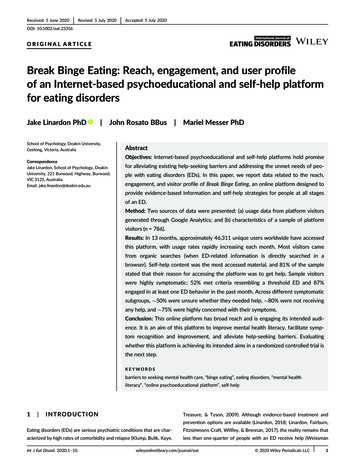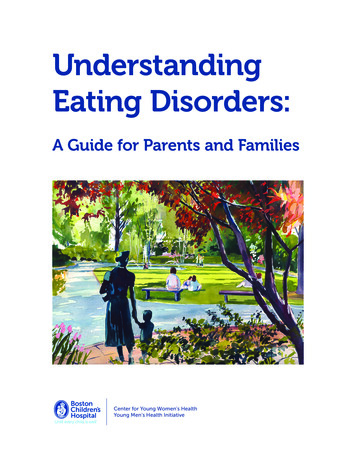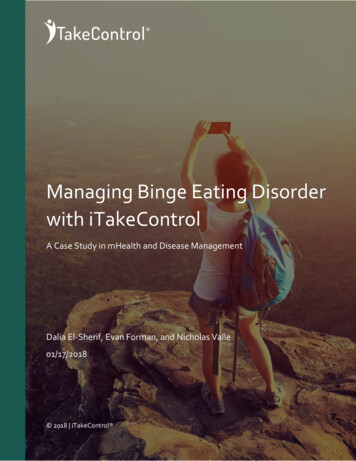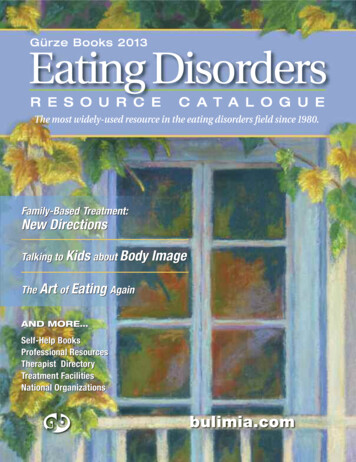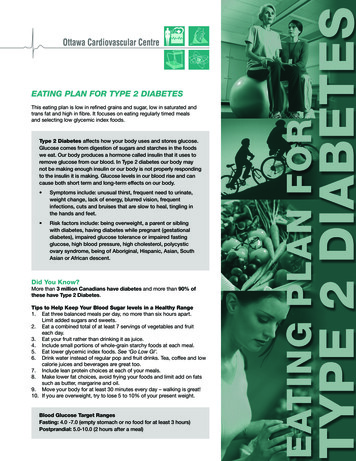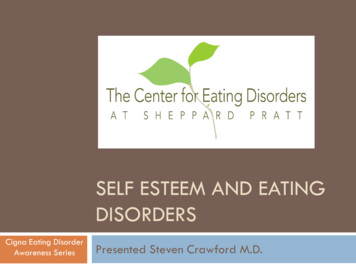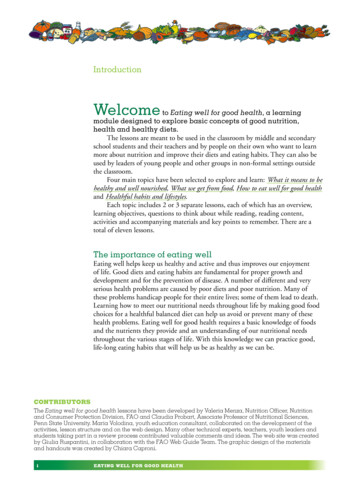
Transcription
IntroductionWelcome to Eating well for good health, a learningmodule designed to explore basic concepts of good nutrition,health and healthy diets.The lessons are meant to be used in the classroom by middle and secondaryschool students and their teachers and by people on their own who want to learnmore about nutrition and improve their diets and eating habits. They can also beused by leaders of young people and other groups in non-formal settings outsidethe classroom.Four main topics have been selected to explore and learn: What it means to behealthy and well nourished, What we get from food, How to eat well for good healthand Healthful habits and lifestyles.Each topic includes 2 or 3 separate lessons, each of which has an overview,learning objectives, questions to think about while reading, reading content,activities and accompanying materials and key points to remember. There are atotal of eleven lessons.The importance of eating wellEating well helps keep us healthy and active and thus improves our enjoymentof life. Good diets and eating habits are fundamental for proper growth anddevelopment and for the prevention of disease. A number of different and veryserious health problems are caused by poor diets and poor nutrition. Many ofthese problems handicap people for their entire lives; some of them lead to death.Learning how to meet our nutritional needs throughout life by making good foodchoices for a healthful balanced diet can help us avoid or prevent many of thesehealth problems. Eating well for good health requires a basic knowledge of foodsand the nutrients they provide and an understanding of our nutritional needsthroughout the various stages of life. With this knowledge we can practice good,life-long eating habits that will help us be as healthy as we can be.CONTRIBUTORSThe Eating well for good health lessons have been developed by Valeria Menza, Nutrition Officer, Nutritionand Consumer Protection Division, FAO and Claudia Probart, Associate Professor of Nutritional Sciences,Penn State University. Maria Volodina, youth education consultant, collaborated on the development of theactivities, lesson structure and on the web design. Many other technical experts, teachers, youth leaders andstudents taking part in a review process contributed valuable comments and ideas. The web site was createdby Giulia Ruspantini, in collaboration with the FAO Web Guide Team. The graphic design of the materialsand handouts was created by Chiara Caproni.iEATING WELL FOR GOOD HEALTH
Module structureThis module is made up of four topics which are divided into eleven lessons.Topic 1 What it means to be healthy and well-nourished is aboutthe many factors that affect our health and well-being. It explains how ournutritional status depends both on our personal choices and on fundamentalconditions such as nutritious food, clean water, medical care and education.It shows how poverty is an underlying cause of most forms of malnutrition anddiscusses the serious health problems caused by poor nutrition. It describes themost common problems of poor nutrition, their signs and symptoms.Lesson 1 Exploring the meaning of good health and well-beingLesson 2 Analyzing the conditions that affect nutritional statusLesson 3 Understanding problems of poor nutritionTopic 2 What we get from food is about the nutrients we get from foodsand how important it is for proper growth and development and prevention ofdisease to eat the right variety and the right amounts of foods that provide thesenutrients. It explains the functions of carbohydrates, protein, fats, vitamins andminerals in the body and their importance in the diet. It provides some examplesof foods that are good sources of these nutrients.Lesson 4 Learning about carbohydrates, protein and fatsLesson 5 Learning about vitamins and mineralsTopic 3 How to eat well for good health is about how to make goodfood choices for a healthy balanced diet throughout life. It describes the differentnutritional needs at different stages of life and discusses the importance ofdeveloping good dietary practices and eating habits. It includes practical adviceon how to choose clean, fresh and nutritious foods and how to store and preparethem safely at home.Lesson 6 Meeting nutritional needs throughout lifeLesson 7 Making good food choices and healthy mealsLesson 8 Keeping foods safe and nutritiousTopic 4 Healthful habits and lifestyles is about how body weight,physical activity, good personal hygiene and clean surroundings affect our health.It explores what a healthy body size is and how to achieve a healthy weight bykeeping energy in balance. It discusses the importance of physical activity andfitness for good health and weight. It explains how protecting ourselves fromgerms that cause disease is an important part of keeping well and healthy.Lesson 9 Achieving good body size and weightLesson 10 Keeping fit and activeLesson 11 Keeping ourselves, our water and our surroundings cleaniiEATING WELL FOR GOOD HEALTH
How to use the lessonsThe Eating well for good health lessons can be used both in theclassroom by students and teachers, and outside the classroom by groups ofpeople or individual learners exploring the issues of health and nutrition. Everylesson contains each of the sections below. Longer lessons covering severaldifferent concepts are divided into separate lesson parts, each one with its ownlesson reading, questions to think about, materials, activities and key points. It issuggested that each lesson part be taught or studied as a separate lesson.Lesson OverviewEvery lesson starts with a short summary of the information presented in thatlesson. Teachers can use the overview to introduce the main concepts of the lessonto their students, while individual learners can review it to understand what thelesson is about.Learning ObjectivesThis section lists things learners should know and be able to do by the end of thelesson. It can be used during the lesson to remind students of the skills they areto learn and to help them focus their attention on the main issues. It can also bereviewed at the end of the lesson to evaluate the knowledge, skills and attitudesthat have been acquired.MaterialsA number of fact sheets, figures, tables, graphs, worksheets and other materials areprovided for each lesson. They can be adapted and enriched according to the needsof the learners and the settings in which they are studied. Some of the materialscontain additional, more detailed information to complete the “Reading” that canbe used as a handy reference or as information to take home from school. Othermaterials are designed to be used as worksheets during the activities. They shouldbe printed out or copied in notebooks, on blackboards or flipcharts so that theycan be completed in groups or individually.To think about while readingThis section contains key questions to reflect on before, during and after readingthe text. Teachers can use these questions to introduce the “Reading” or as astarting point for discussion and exchange of opinions on the topic of the lesson.Individual learners can use the questions to reflect on the concepts presented inthe lesson.iiiEATING WELL FOR GOOD HEALTH
ReadingThis section contains the basic reading material that provides the core informationof each lesson part. The reading should be printed out, projected on walls orscreens or copied in notebooks, on blackboards or flipcharts. It can be readindividually, in groups or aloud to the whole class. The text should be studied anddiscussed before doing the activities.ActivitiesA range of different types of activities - individual thinking and analyses, groupdiscussions, matching games, quizzes, true or false statements, communityresearch and assessment - is provided for people to choose from depending ontheir ability, needs, interests and time. The activities are based on the “Reading”and are designed to help learners test their understanding of the basic concepts ofthe lesson and apply it to their own lives. Most of the activities can be carried outwith limited resources and can be done by both individual and group learners.Teachers can also create new activities to suit their students’ needs and culturalbackgrounds.Key PointsEvery lesson part concludes with the key points to understand and remember.These points can be used for discussion and further investigation of the topicspresented in the lesson section. They can also be used to evaluate learners’understanding of the topic. Groups and classes can use them as “take home”messages to share with family and friends.ivEATING WELL FOR GOOD HEALTH
Topic 1What it meansto be healthyand well-nourishedWhat it means to be healthy and well-nourishedis about the many factors that affect our health andwell-being. It explains how our nutritional status dependsboth on our personal choices and on fundamental conditionssuch as nutritious food, clean water, medical care andeducation. It shows how poverty is an underlying causeof most forms of malnutrition and discusses the serioushealth problems caused by poor nutrition. It describes themost common problems of poor nutrition, their signs andsymptoms.Lesson 1Exploringthe meaning ofgood healthand well-beingEATING WELL FOR GOOD HEALTHLesson 2Analyzingthe conditionsthat affectnutritional statusLesson 3Understandingproblemsof poornutrition
Topic 2What we getfrom foodWhat we get from food is about the nutrients weget from foods and how important it is for proper growthand development and prevention of disease to eat the rightvariety and the right amounts of foods that provide thesenutrients. It explains the functions of carbohydrates, protein,fats, vitamins and minerals in the body and their importancein the diet. It provides some examples of foods that are goodsources of these nutrients.Lesson 4Learning aboutcarbohydrates,protein and fatsEATING WELL FOR GOOD HEALTHLesson 5Learning aboutvitamins andminerals
Topic 3How to eat wellfor good healthHow to eat well for good health is about howto make good food choices for a healthy balanced dietthroughout life. It describes the different nutritional needsat different stages of life and discusses the importanceof developing good dietary practices and eating habits.It includes practical advice on how to choose clean, freshand nutritious foods and how to store and prepare themsafely at home.Lesson 6Meetingnutritional needsthroughout lifeEATING WELL FOR GOOD HEALTHLesson 7Makinggood food choicesand healthy mealsLesson 8Keepingfoods safe andnutritious
Topic 4Healthful habitsand lifestylesHealthful habits and lifestyles is about how bodyweight, physical activity, good personal hygiene and cleansurroundings affect our health. It explores what a healthybody size is and how to achieve a healthy weight by keepingenergy in balance. It discusses the importance of physicalactivity and fitness for good health and weight. It explainshow protecting ourselves from germs that cause disease isan important part of keeping well and healthy.Lesson 9Achievinggood body sizeand weightEATING WELL FOR GOOD HEALTHLesson 10Keeping fit andactiveLesson 11Keeping ourselves,our water andour surroundingsclean FAO, 2011
reviewed at the end of the lesson to evaluate the knowledge, skills and attitudes that have been acquired. MATERIALS A number of fact sheets, figures, tables, graphs, worksheets and other materials are provided for each lesson





